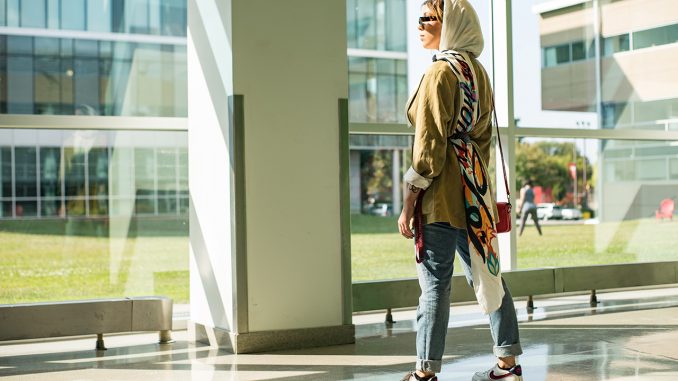
Hijabs, a religious headcovering worn by some Muslim women, are starting to appear in the Western fashion industry.
Halima Aden, a 21-year-old Somali-American, became the first model to walk in New York Fashion Week wearing a hijab in 2017, W Magazine reported. She has been featured in British Vogue, campaigns with Fenty Beauty and American Eagle, and was one of E! News’ Front Five hosts for this year’s NYFW.
Brands like Dolce & Gabbana, DKNY and Tommy Hilfiger have made special collections featuring the hijab, Mic.com and Fortune.com reported. The hijab fashion industry is set to reach $488 billion this year, WHYY reported.
“Hijab has transformed not only with the culture and society of the time but also with the way that women perceive it and choose to cover,” said Nora Alamiri, a senior public health major and member of the College of Public Health’s Diversity Committee.
It wasn’t easy to be a hijabi as a child in King of Prussia, Pennsylvania Alamiri said. Today, Muslim girls can look to Congresswoman Ilhan Omar (D-MI) and Olympian fencer Ibtihaj Muhammad to see themselves in mainstream American culture, but these role models weren’t visible when Alamiri was growing up, she added.
“I had to come to my own decisions and my own beliefs that this is something for me that is a symbol of strength and I choose to wear it because truthfully, I don’t want to be like everybody else,” Alamiri said. “I want to stand out because, even now in a country where so much is homogenized, it’s kind of unique and cool.”
President of Ahmadiyya Muslim Student Association for Women and senior biology major Kurat Abaidullah said that growing up, she felt her hijab made her unique when she was a student at Little Flower Catholic High School for Girls in Hunting Park. Now, she’s happy to be among fellow hijabis and other Muslim students on campus.
“At Temple, fashion in Islam unifies us because when people are walking around like, ‘Hey I like your shoes’ or ‘Hey I like your sweater,’ [Muslim girls are] going around like, ‘Oh my god, where did you get that hijab? I love that!’” Abaidullah said.
Typically, Abaidullah said, she shops at The Islamic Place, which sells modest clothing like the hijab. She and other hijabis have made do with scarves from department stores like Kohl’s and Sears, but a growing online presence from brands like Haute Hijab and Annah Hariri have made hijabs more available.
This evident demand, combined with a desire to fuse hijabi and street style, has inspired Alamiri to create her own hijabs.
Her first design — slated to be sold on the up-and-coming Philadelphia clothing brand Live By Faith, Inc. — is a plain white scarf with a colorful floral background. Over the flowers is the Arabic word “Modesty,” a nod to Alamiri’s own heritage. Below, in English, bold letters say “For modesty.” She chose modesty because it’s the whole purpose of the hijab.
“Modesty means something different to everyone,” she said. “It’s everyone’s personal choice, and whatever way she chooses to cover, that’s up to her. Modesty is a spectrum, and you cannot judge somebody for the way she chooses to cover.”
Hafeezat Bishi, a sophomore communication and social influence major, said people misinterpret the religious meaning of modesty.
“Hijab means ‘of modesty,’ so when you wear hijab you have to be modest not only in outward appearance but in how you speak, but people like to conflate that with being docile,” Bishi said. “A lot of people don’t think a woman in hijab can be outspoken, can be a leader, can make a change, which is what these women are doing right now.”
Modest fashion being more visible is definitely a good thing, Alamiri said, but she urged people to be wary of major fashion labels who do not use authentic hijabi models.
“I think that’s dangerous when you use someone who isn’t of the culture to represent the culture because there’s a fine line between representation and misuse of minorities,” she said.
Alamiri said she buys her hijabs from hijabi entrepreneurs to support women who share her values, which she hopes people will remember as the hijab becomes more en vogue.
“If people don’t forget that it’s a religious symbol, I think it’s great,” Abaidullah said. “I think the second they start abusing it and making it more of a fashion statement instead of realizing that it’s a symbol that you’re a Muslim ambassador, it might become a slippery slope.”



Be the first to comment